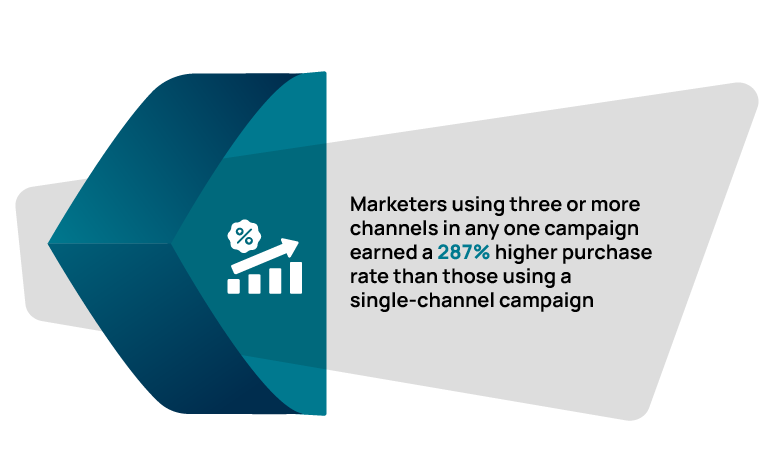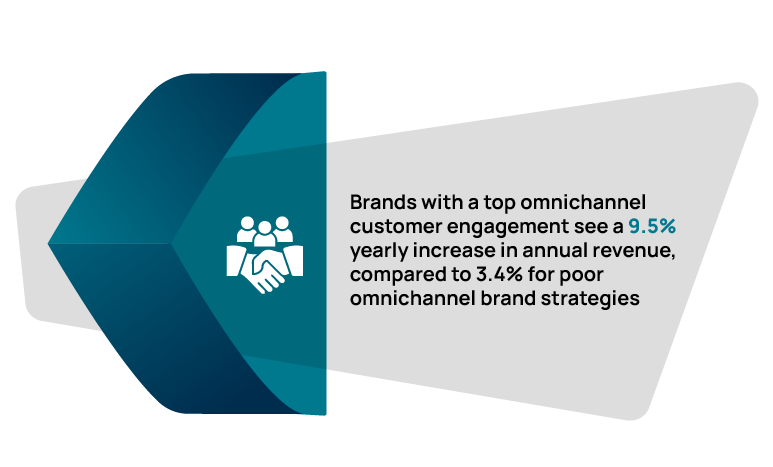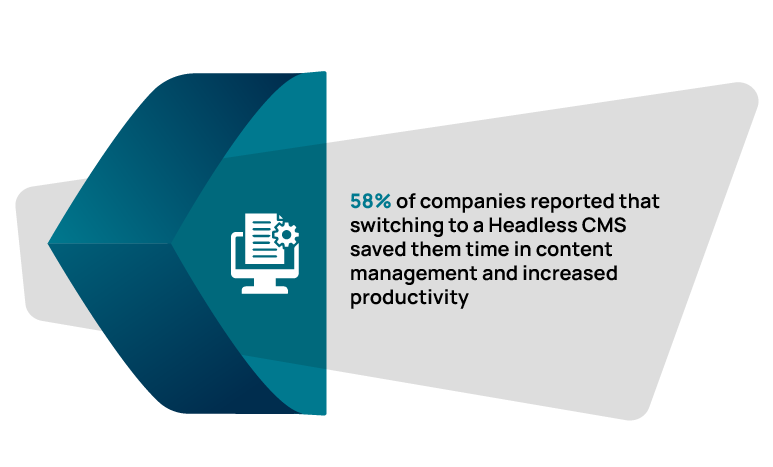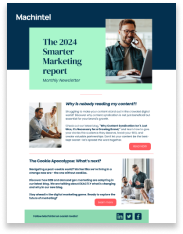How to Implement Headless CMS Tactics in Omnichannel Marketing
Discover the impact of a mobile-first approach with Headless CMS. Explore how leveraging Headless CMS in omnichannel marketing enhances digital strategy for customer experiences across all channels.
Introduction to Omnichannel Marketing

[Source: Porch Group Media]
Omnichannel marketing, a powerful strategy that enhances the consumer journey through the sales funnel, offers a host of benefits. By blending branding, messaging, and interactions across online and offline channels, it provides a comprehensive approach that prioritizes a consumer-centric viewpoint. This is crucial in today's world where consumers engage with brands across a multitude of platforms, from social media to direct customer service interactions.
Omnichannel marketing delivers critical advantages by ensuring a consistent and positive experience across each touchpoint. It creates a uniform brand tone and vision that enhances brand recognition and fosters a stronger brand identity. Moreover, it enables personalized messaging tailored to individual interests and past interactions, increasing customer engagement. Lastly, it ensures that the content is dynamically shaped by the consumer's current stage in the buying journey, leading to more relevant and effective communication.
Multichannel versus Omnichannel Marketing Strategies
Ever wondered about the difference between omnichannel and multichannel marketing? Both strategies involve reaching out to customers on different platforms but have distinct approaches. Multichannel marketing uses various channels to complete sales or interactions, while omnichannel marketing is all about ensuring the customer has a seamless experience as they switch between different channels.
Let's take a closer look at what sets these two approaches apart:

Utilizing a Headless CMS for Omnichannel Content Distribution

[Source: Digizuite]
The decision to employ a headless CMS for omnichannel content distribution marks the beginning of a strategic journey. This approach offers significant advantages in terms of versatility and scalability for content management across various platforms.
Understanding Customer Preferences
Effective content distribution necessitates a profound understanding of the target audience’s preferences, needs, and challenges. Engaging in comprehensive market research and behavior analysis to gather insights is crucial. Such knowledge allows for the creation of content that not only resonates with the audience but also enhances engagement levels.
Channel Identification for Target Audience
It is essential to pinpoint the most effective channels for reaching the target audience. This process involves a meticulous evaluation of various mediums, including websites, social media, mobile applications, and email campaigns. Determining where the target audience is most active will inform a tailored content distribution strategy.
Selection of a Suitable Headless CMS
Choosing an appropriate Headless CMS is critical. The ideal CMS should offer robust functionality, high scalability, and an intuitive user interface. It is essential to consider its capabilities in content management, integration ease, and versatility in handling multiple content formats. A well-chosen CMS serves as a powerful engine for content distribution.
Content Creation
Creating engaging and relevant content is a dynamic and creative process. It involves developing materials that address the audience’s pain points and align with their interests, whether through articles, videos, infographics, or podcasts. Consistency in brand voice across all formats and channels is crucial in reinforcing brand identity.
Customization of Content for Enhanced Engagement
Adapting content to suit different channels is imperative for maximizing engagement. Each channel has unique characteristics and limitations, which should guide content customization. This includes optimizing visual elements and interactive features along with using platform-specific capabilities to offer a personalized audience experience.
Efficient Multi-Channel Content Delivery
With the content ready and tailored for different channels, the next step is to deploy these assets using the chosen Headless CMS. This system should enable seamless content delivery to various touchpoints by effectively using APIs and integrations, ensuring a consistent and synchronized distribution strategy.
Performance Monitoring and Analytics
Monitoring the impact of content distribution is vital. Utilizing analytics tools to track key performance indicators such as audience engagement, conversion rates, and overall channel effectiveness is recommended. This data is invaluable for refining strategies, pinpointing improvement areas, and making informed decisions to optimize the content distribution framework.
Mobile-first Approach in Omnichannel Marketing
Implementing a mobile-first strategy through a Headless CMS in omnichannel marketing is essential for businesses targeting mobile users. This approach enhances user engagement and SEO efficiency, increasing organic traffic while ensuring content is tailored for mobile devices from the outset rather than being adapted from desktop formats.
Mobile-First Approach with Headless CMS: A Step-by-Step Guide
When an organization integrates a Headless CMS with a mobile-first approach, it produces and distributes content optimized for mobile devices while leveraging decoupled CMS benefits in marketing architecture.
Here's a detailed explanation of the process:
- Choosing a Headless CMS: Identify a CMS that aligns with the organization's requirements.
- Designing for Mobile-First: Determine essential mobile user behaviors, preferences, and constraints.
- Content Creation and Management: Develop and organize content using a structured approach.
- Front-end Development: Select appropriate technologies that fulfill a superior mobile experience requirement.
- API Integration: Employ APIs from the Headless CMS to fetch and display content on mobile applications or mobile-responsive websites.
- Testing and Optimization: Test the mobile content and interface on various devices and screen sizes to guarantee a seamless user experience.
- Iteration and Improvement: Continually assess user interactions, gather analytical data, and refine the mobile content strategy based on user insights.
Advantages of a Mobile-First Approach
Adopting a mobile-first approach and pairing it with a Headless CMS offers substantial benefits by optimizing content for mobile usability and accessibility. Some of the benefits of a mobile-first approach include:
- Enhanced User Experience: By giving precedence to mobile users, the content is made more accessible and engaging on compact screens, which enhances the overall user experience.
- Improved SEO Performance: Search engines, including Google, consider mobile-friendliness a critical ranking criterion. Adopting a mobile-first approach improves content's SEO, enhancing its visibility.
- Increased Engagement and Conversion Rates: Content that is optimized for mobile tends to record higher engagement and conversion rates, effectively catering to mobile users.
- Streamlined Content Strategy: Initiating content creation with a mobile perspective compels creators to concentrate on the most crucial elements, yielding more precise and potent messaging across all channels.
SEO Approaches for Headless CMS in Omnichannel Marketing
In omnichannel marketing, using a Headless CMS requires thorough SEO strategies to reach the target audience.
Headless CMS offers unique opportunities for bespoke SEO tactics across channels despite the challenges of decoupling content and presentation layers. Prioritizing site speed, enhancing user interaction, and ensuring cross-channel optimization can significantly boost search engine visibility and traffic.
Unlike traditional CMS systems with built-in SEO functionalities, a Headless CMS requires a hands-on approach to optimize content across various channels effectively, enhancing visibility and traffic.
Following are some of its advantages:
- Organizations have the flexibility to develop and implement SEO tactics specifically tailored to meet each channel's distinct needs, enhancing the content's overall effectiveness.
- A Headless CMS can significantly improve site loading times, pivotal for achieving higher SEO rankings and enriching the user experience.
- By optimizing content for various channels, companies can elevate the overall user experience, indirectly benefiting SEO through heightened user engagement and lower bounce rates.
- It facilitates the optimization of content for search engines across all channels, promoting a cohesive SEO strategy that aligns with extensive omnichannel marketing objectives.
Headless CMS Integration Challenges in Marketing
Integrating a Headless CMS into omnichannel marketing strategies introduces several challenges due to its architecture, which decouples content management from content presentation.
This structure demands more technical expertise and coordination between the marketing and IT departments to ensure effective content delivery across multiple platforms and devices.
Some of its challenges and solutions are as follows:
Technical Complexity
Developers face increased technical demands and resource allocation challenges as they are required to build and maintain separate front-end applications for each channel.
Development can be streamlined using shared libraries and reusable frameworks across platforms. Additionally, leveraging low-code platforms can expedite development and maintenance.
Content Strategy Alignment
Achieving consistency and personalization across all channels necessitates a refined content strategy and enhanced collaboration between content creators and developers.
Next-gen content management protocol can be implemented to standardize content across channels while allowing customization. Agile methods can be used to enhance team collaboration and responsiveness to change.
Integration with Other Systems
Headless CMS needs to be integrated with additional systems like CRM, e-commerce platforms, and analytics tools, which can be intricate and labor-intensive.
Middleware solutions can be adapted to facilitate integration and ensure seamless data flow between systems. APIs and standardized data formats can be utilized to simplify connections.
Training and Adoption
Marketing teams might require training on new workflows and tools as Headless CMS platforms often lack the intuitiveness of traditional CMSs with integrated front ends.
Comprehensive training programs can be developed, including hands-on sessions and continuous support. The Headless CMS can be gradually phased in to allow marketing teams time to adjust to the new system.
Headless CMS Integration Best Practices

[Source: Storyblok]
Implementing a Headless CMS in omnichannel marketing involves decoupling content management from content delivery, allowing seamless content distribution across various channels.
Some of the best practices include:
- Articulate precise business objectives before Headless CMS implementation and delineate how the platform will bolster these objectives across varied channels.
- Cultivate a profound comprehension of the target audience and their channel-specific preferences to tailor content effectively.
- Promote collaboration among marketing, IT, and design teams to ensure seamless deployment and operation of the Headless CMS.
- Offer comprehensive training to equip the team with proficiency in using the Headless CMS and ensure optimal utilization of its capabilities.
- Design content in a modular fashion, facilitating its reuse across channels and streamlining management and updates.
- Exploit the API-driven content strategies of Headless CMS to integrate with other tools and platforms, thereby augmenting the omnichannel experience.
- Adhere to the latest security standards to safeguard content and user data across the Headless CMS and its integrations.
- Regularly monitor performance metrics and solicit feedback to refine and optimize the content strategy iteratively.
Future Trends in Headless CMS and Marketing
Headless CMS and omnichannel marketing are evolving due to technological advancements and shifting consumer expectations. Businesses increasingly integrate Headless CMS into omnichannel strategies to achieve greater agility and personalized engagement across all user touchpoints. This evolution is driven by several key trends shaping the future of content management and delivery.
Implementing Headless CMS personalization alongside AI and ML will automate content optimization, elevating the effectiveness and dynamism of content strategies. With the rise of voice search and smart speakers, Headless CMS needs to adapt content for delivery across conversational interfaces, enriching the omnichannel experience. Integrating AR and VR into omnichannel marketing will require Headless CMS platforms to manage immersive content types, offering innovative customer engagement opportunities. Growing concerns over data privacy will drive Headless CMS evolution toward more secure and compliant handling of personal data across channels. Blockchain technology could ensure content authenticity and integrity, enabling transparent and verifiable content management processes.
The future of Headless CMS and omnichannel marketing is characterized by technological innovation and a deeper focus on personalized, immersive customer experiences. As AI, AR/VR, voice interfaces, and data privacy concerns become more prominent in digital strategies, Headless CMS platforms will adapt to support these trends, offering flexible, efficient, and secure content management solutions. These developments promise to enhance businesses' ability to engage with customers in meaningful ways, driving the effectiveness of omnichannel marketing strategies and establishing new standards for digital experiences.

By submitting this form I have read and acknowledged the Terms of Use and the Privacy policy
